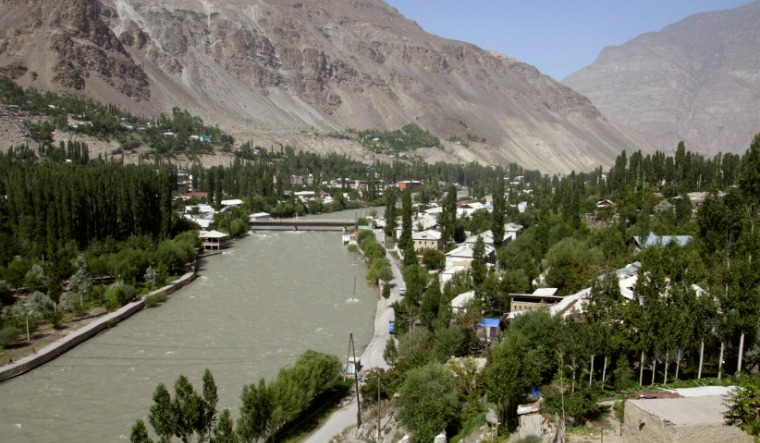The smallest Central Asian country, Tajikistan, is reported to have crammed in a Chinese military base to the Indian and Russian ones that already exist. The Chinese base, if reports are to be believed, has been built at a cost of ten million dollars. The Tajik government has denied reports so far, but there is no doubt that China is determined to fight for leverage in the region.
The base is believed to be in the eastern Gorno-Badakhshan autonomous province near the Pamir mountains, and will be the second such facility for the country after Djibouti. The steady gains by China in the region—especially in the Taliban-dominated Afghanistan where India has limited room to manoeuver—will certainly be a concern for South Block. This is the heart of China's Belt and Road initiative, and China's financial clout in the region is already on display. So far, China has invested more than $100 billion in these infrastructure projects, according to a paper by India and China in Central Asia: Understanding the new rivalry in the heart of Eurasia by the Observer Research Foundation.
China's projection of military might comes at a time when India's main plank for the region, connectivity, is in disarray with the instability in Afghanistan. Trade ties with the Central Asian Republics apart, the situation will also have an impact on India's dream port project of Chabahar. "Connectivity will be a challenge going forward,'' said Harsh Pant, Director Studies and Head of the Strategic Studies Programme at Observer Research Foundation. "As the security situation deteriorates, no one wants to spend on it at this point. Central Asians will not want extremism or radicalisation to travel through the connectivity routes. Any country in the region is looking at connectivity as a prism of leverage, and they wouldn't want any kind of legitimacy for the Taliban, or any move that makes them vulnerable to negative externalities emerging from Afghanistan."
For India, which had underpinned its engagement in the region with an emphasis on connectivity, this is a body blow. India has been dreaming of a connected Central Asia since the 1990s with the emergence of the Central Asian Republics. In 2015, when Prime Minister Narendra Modi made his grand outreach to Central Asia, connectivity and culture were at the heart of his promise. Progress has been slow. But, it is a dream worth holding on to, as China makes inroads economically in the region. The hydrocarbons from the region are essential for China's energy ambitions.
The trade figures of Kazakhstan, Uzbekistan, Turkmenistan, Kyrgyzstan and Tajikistan with India was below two billion dollars in 2018. China's trade for the same period is estimated to be 50 to 60 billion dollars. In 2018, New Delhi joined the Ashgabat agreement—between Kazakhstan, Uzbekistan, Turkmenistan, Iran, Iran, Pakistan and Oman—to create an international transport and transit corridor that would link this region to the Persian Gulf. China's proximity to the region certainly helps. The animosity between India and Pakistan, which ensures that connectivity projects don't take off, also adds to the tension.
The fate of the Chabahar Project, especially in Afghanistan with the Taliban, hangs fire. The project, which was delayed in President Donald Trump's sanction regime, as very few firms were willing to invest even though India had got a waiver, is now facing its biggest challenge. "Chabahar is facing a moment of reckoning,'' says Pant. "Strategically, Chabahar has made sense. But, at the moment, the Afghan political economy is such that unless there is something credible for India, what do we do going forward?''
Prime Minister Narendra made a public pitch for the project at the Shanghai Cooperation Organisation (SCO) summit in September. “We believe that land-locked Central Asian countries can benefit immensely by connecting with India's vast market. Unfortunately, many connectivity options are not open to them today due to a lack of mutual trust. Our investment in Iran's Chabahar port and our efforts towards the International North-South Corridor are driven by this reality,'' he said in a speech delivered via a video link.
However, the public endorsement apart, India will find it difficult to be able to make a go of the port under the current situation. India had been batting for connectivity with the Port with Uzbekistan—an element that was likely to make Chabahar a reality. But as the Taliban control of Afghanistan inched closer, India was replaced in a similar agreement with Pakistan. India is still determined to find solutions. The Minister of External Affairs S. Jaishankar travelled to the region thrice in the past few months. In October, he went to Kyrgyzstan and extended a credit line of $200 million for the support for development projects. Then, he travelled to Kazakhstan to attend the sixth Foreign Ministers’ Conference on Interaction and Confidence-Building Measures in Asia (CICA), where he attacked China's BRI, echoing Modi's stance that greater connectivity was essential for regional stability, but it must not be pursued for parochial interests. And later this month, India is trying its hand at bringing regional powers together for an understanding of Afghanistan. Pakistan has refused to come as it does not include the Taliban. China, too, will not attend. But India has reached out to Uzbekistan and Iran. Can there be a solution for greater engagement, without connectivity?





